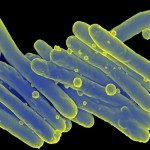Lien vers Pubmed [PMID] – 23284869
PLoS ONE 2012;7(12):e52059
The recently described ESX-5 secretion system of Mycobacterium tuberculosis is one of the most important modulators of host-pathogen interactions due to its crucial impact on PPE protein secretion, cell wall stability and virulence. Although various components of the ESX-5 secretion machinery have been defined, other ESX-5 core components still remain to be characterized. In this study, we focused on EccB(5) and EccC(5), a transmembrane protein (EccB(5)) and a membrane-bound ATPase (EccC(5)), both predicted to be building blocks of the M. tuberculosis ESX-5 membrane-associated complex. In vitro expression studies demonstrated that EccB(5) and EccC(5) encoding genes constitute an operon. The expression of this operon is essential for M. tuberculosis, since the deletion of the eccB(5)-eccC(5) genomic segment at the ESX-5 locus is possible only after the integration of a second functional copy of eccB(5)-eccC(5) genes into the M. tuberculosis chromosome. The characterization of two M. tuberculosis conditional mutant strains (Mtb(Pptr)eccB(5) and Mtb(Pptr)eccC(5)), in which the eccB(5)-eccC(5) operon or the eccC(5) gene, respectively, were expressed under the control of an anhydrotetracycline-repressible promoter, confirmed that the repression of eccB(5)-eccC(5) genes is detrimental for growth of M. tuberculosis both in vitro and in THP-1 human macrophage cell line. Moreover, analysis of the secretome of Mtb(Pptr)eccB(5)-eccC(5) and Mtb(Pptr)eccC(5) strains revealed that both EccB(5) and EccC(5) are required for secretion of ESX-5 specific substrates, thus confirming that they are indeed components of the ESX-5 secretion machinery. Taken together these findings demonstrate the importance of an intact and functional ESX-5 system for viability of M. tuberculosis, thus opening new interesting options for alternative antimycobacterial control strategies.

